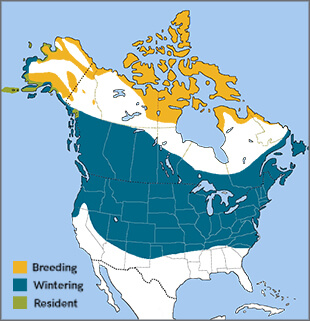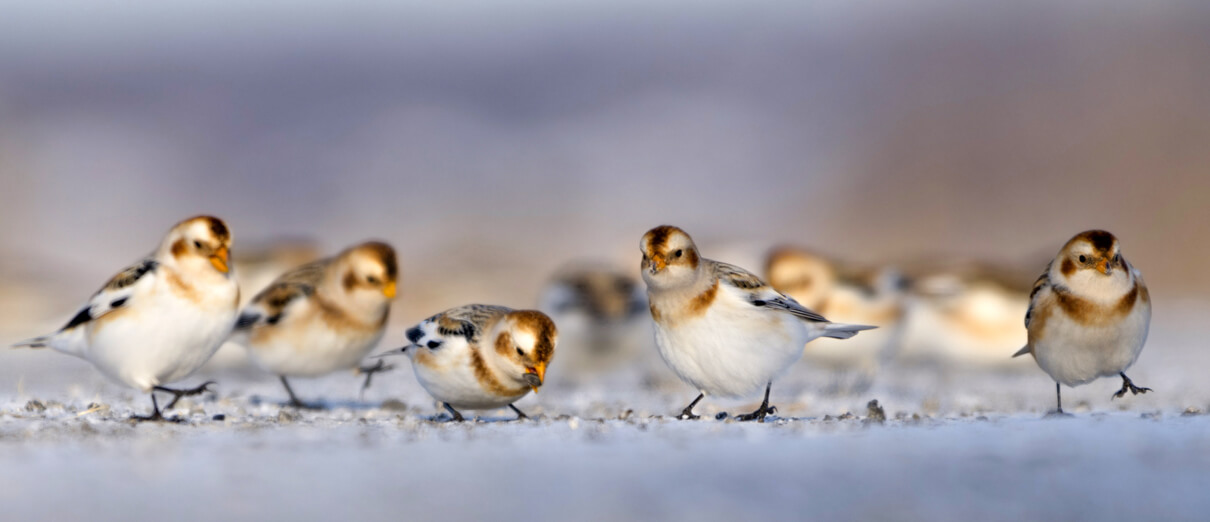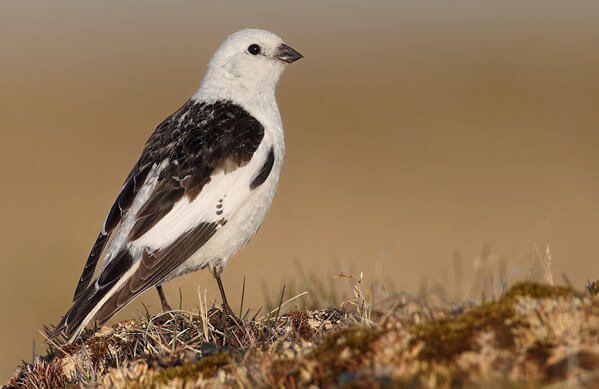
Snow Bunting range map by Cornell Lab of Ornithology
The aptly named Snow Bunting is a bird of extremes. It may look like a feathered snowflake, but don't let its small size and immaculate white feathers fool you: The Snow Bunting is a tough survivor that breeds on frozen tundra in sub-zero temperatures. It's also the most northerly recorded passerine in the world.
Adapted to Extremes
One of the Snow Bunting's most obvious adaptations to its extreme environment is its color. Like the Snowy Owl, Arctic Hare, Arctic Fox, Polar Bear, and ptarmigans, its mostly white coloration serves as effective camouflage in its open, snow-covered habitat. Snow Buntings also have feathering on their ankles, an adaptation providing added warmth on the high Arctic tundra of North America, Europe, and Russia.
Even though Snow Buntings migrate southward to avoid the worst of the Arctic winter, they seldom stray far from cold temperatures. Little wonder one of this bird's nicknames is "snowflake!"
(Audio by Patrik Åberg, XC406439. Accessible at www.xeno-canto.org/406439)
Snowflake Bird
The Snow Bunting is a member of the family Calcariidae, which includes other open-area birds such as the Thick-billed and Chestnut-collared Longspurs. Four subspecies of Snow Bunting are recognized, each differing slightly in the plumage pattern of breeding males.
Male and female Snow Buntings appear similar during the fall and winter, with gray- and brown-streaked backs, buffy wing and body feather edging, and reddish-buff collar and flanks. But later in the winter, males begin their transformation: They actively rub their drab plumage on the snow, wearing off feather tips to reveal their striking breeding plumage. When this transformation is complete, the male birds show a snow-white body contrasting with black back, wing tips, and central tail feathers.
Early Arctic Arrivals
Male Snow Buntings are the first migrant birds to return to the Arctic each spring, showing up in mid-March to early April when snow may remain on the ground and temperatures can still plunge to 30 degrees below zero. Males arrive early to claim and defend prime territories with suitable nesting sites. When the females arrive, around four to six weeks later, the males display for them with aerial acrobatics. As the Horned Lark and Sprague's Pipit do, male Snow Buntings soar high into the air and glide down again while singing beautiful warbling songs.
Once a female Snow Bunting chooses a territory and mate, she builds a nest of grasses and moss, lined with fur and feathers for extra warmth. Her nest is sited in a rocky cavity or cliff crevice, helping to keep her nestlings safe from predation. Male Snow Buntings feed their mates on the nest, enabling the female to continuously protect her eggs from the cold.
Snow Buntings feed on the ground, foraging for a variety of seeds and buds as well as insects and other small invertebrates, including small marine crustaceans in coastal areas. Snow Buntings may form large foraging flocks in winter, often mixing with Horned Larks and longspurs.

Snow Buntings in winter plumage. Photo by Dave Doe/Shutterstock
Mysterious Declines
Although most of the Snow Bunting's breeding habitats are far from human activities, Christmas Bird Count data show a 64-percent decline in North American populations over the past 40 years. Climate change could spell trouble for Snow Buntings, as warmer springtime temperatures trigger earlier insect abundance and put the birds out of sync with peak availability of their food sources. This can lead to lower survivorship in hatchlings.
Warmer temperatures might also pave the way for other bird species to expand their ranges into the Arctic, possibly competing with Snow Buntings for finite resources.
Another threat to the Snow Bunting is pesticide use, since this bird often feeds in agricultural fields during the winter. A class of pesticides known as neonicotinoids is a particular concern for these and other birds that frequent agricultural areas. As nocturnal migrants, Snow Buntings are also at some risk from collisions, particularly at wind energy facilities and airports.
ABC has led efforts to establish Bird-Smart Wind Energy development, which includes siting turbines well away from birds' migratory corridors. We work to assess and advise on potential impacts of proposed projects, raising concerns in places vital for migratory birds, such as the Great Lakes.
Donate to support ABC's conservation mission; 1:1 match through Dec. 31!



















































